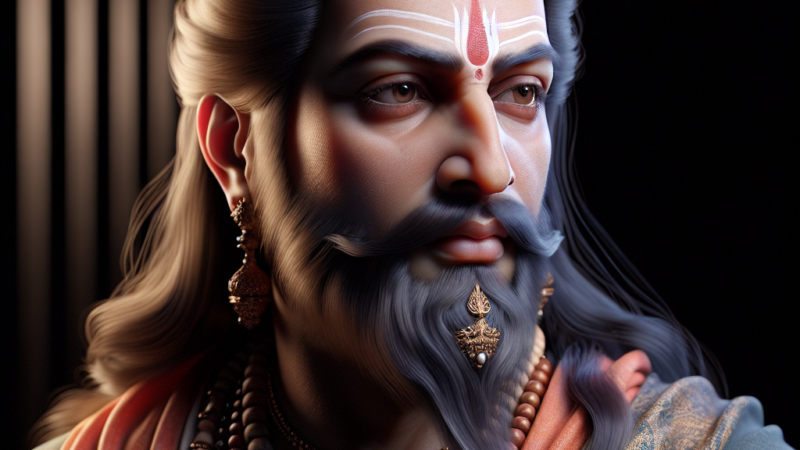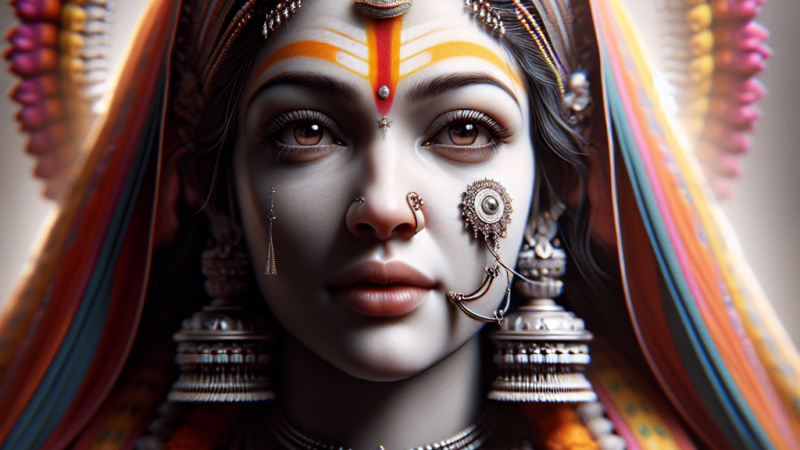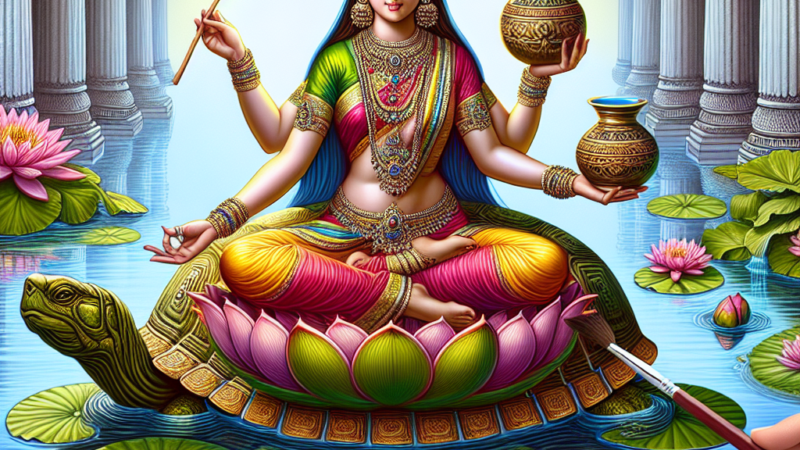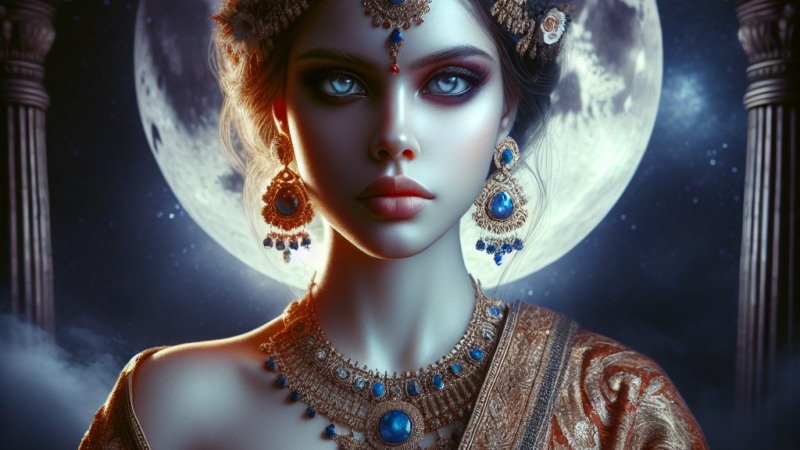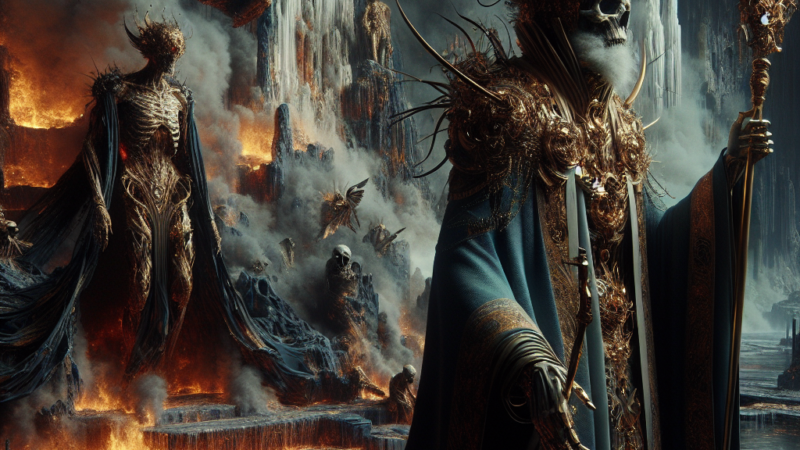Veer Mhaskoba: The Guardian Deity Worshipped in Maharashtra
Introduction

Veer Mhaskoba, a revered guardian deity, holds a significant place in the religious and cultural landscape of Maharashtra, India. Known for his protective and benevolent nature, Veer Mhaskoba is worshipped by numerous devotees who seek his blessings for prosperity, protection, and well-being. This deity is particularly venerated in rural areas, where his influence permeates various aspects of daily life and community practices.
In Hinduism, deities like Veer Mhaskoba play crucial roles in the spiritual and cultural fabric of society. They are often seen as protectors of specific regions, communities, or aspects of life. Veer Mhaskoba, in particular, is celebrated for his role as a guardian deity, safeguarding his devotees from harm and ensuring their prosperity.
Veer Mhaskoba’s attributes and stories are deeply embedded in the local folklore and traditions of Maharashtra. His worship involves a rich tapestry of rituals, festivals, and cultural practices that highlight his importance in the lives of his followers.
Etymology and Meaning
Origin of the Name Veer Mhaskoba
The name “Veer Mhaskoba” is derived from the Marathi language, where “Veer” means “brave” or “heroic,” and “Mhaskoba” is believed to be a local adaptation of the name “Mahishasura,” a demon in Hindu mythology. The name signifies the deity’s valor and strength, attributes that are central to his identity as a guardian deity.
Variations of the Name
While “Veer Mhaskoba” is the most commonly used name, variations such as “Mhaskoba” or “Mhaskoba Maharaj” are also prevalent in different regions and texts. These variations reflect the local dialects and linguistic nuances of the areas where the deity is worshipped.
Symbolic Meaning
The name “Veer Mhaskoba” symbolizes bravery, protection, and heroism. It reflects the deity’s role as a protector and guardian, qualities that are deeply revered by his devotees. The name also underscores the deity’s connection to the local culture and traditions of Maharashtra.
Mythological Origins and Stories
Major Myths and Stories
Veer Mhaskoba’s mythology is rich with tales of valor and protection. One of the most popular stories involves his battle against the demon Mahishasura, from whom his name is derived. According to local legends, Veer Mhaskoba vanquished the demon to protect his devotees, earning their eternal gratitude and reverence.
Role in Major Hindu Epics
While Veer Mhaskoba is not prominently featured in major Hindu epics like the Mahabharata or Ramayana, his stories are deeply rooted in regional folklore. These tales often draw parallels with the broader themes of good versus evil found in Hindu mythology, reinforcing his role as a protector and guardian.
Other Significant Tales
In addition to the battle with Mahishasura, other significant tales include stories of Veer Mhaskoba protecting villages from natural calamities, diseases, and other threats. These stories highlight his benevolent nature and his commitment to safeguarding his devotees.
Iconography and Symbols
Depiction in Art and Temples
Veer Mhaskoba is typically depicted as a fierce warrior, often shown wielding weapons such as a sword or trident. His statues and images can be found in temples and homes, where they serve as focal points for worship and devotion.
Common Symbols
Common symbols associated with Veer Mhaskoba include the sword, trident, and a lion or tiger. These symbols represent his strength, valor, and protective nature. The lion or tiger, in particular, is a common motif in Hindu iconography, symbolizing power and dominance.
Meaning and Significance
The symbols associated with Veer Mhaskoba carry deep meaning for his devotees. The sword and trident signify his ability to protect and defend, while the lion or tiger represents his strength and courage. These symbols reinforce the deity’s role as a guardian and protector.
Worship and Rituals
Festivals Dedicated to Veer Mhaskoba
One of the most significant festivals dedicated to Veer Mhaskoba is the annual “Mhaskoba Yatra,” held in various villages across Maharashtra. This festival involves elaborate rituals, processions, and cultural performances, drawing large crowds of devotees who come to seek the deity’s blessings.
Common Rituals and Practices
Worship of Veer Mhaskoba typically involves daily prayers, offerings of flowers and sweets, and the chanting of specific mantras. Devotees often visit temples dedicated to the deity, where they participate in rituals conducted by priests. Special ceremonies are also held during important life events such as weddings and births, seeking the deity’s blessings for prosperity and protection.
Sacred Texts and Mantras
While there are no specific sacred texts exclusively dedicated to Veer Mhaskoba, his worship is often accompanied by the recitation of mantras and hymns from broader Hindu scriptures. These include verses from the Vedas, Puranas, and other devotional texts that emphasize protection and well-being.
Temples and Sacred Sites
Major Temples
Several temples dedicated to Veer Mhaskoba can be found across Maharashtra. Some of the most prominent ones include the Mhaskoba Temple in Veer, Pune, and the Mhaskoba Temple in Kodit, near Saswad. These temples are important pilgrimage sites, attracting devotees from far and wide.
Significance of These Temples
The temples dedicated to Veer Mhaskoba are not just places of worship but also centers of community life. They host various religious and cultural events throughout the year, serving as focal points for social and spiritual gatherings. The architecture and iconography of these temples also reflect the rich cultural heritage of the region.
Annual Pilgrimages and Events
The annual Mhaskoba Yatra is one of the most significant events associated with the deity. Held at various temples, this pilgrimage involves processions, rituals, and cultural performances, drawing large crowds of devotees. The event is a vibrant celebration of faith and community, highlighting the enduring importance of Veer Mhaskoba in the lives of his followers.
Regional Variations and Cultural Impact
Regional Worship Practices
While Veer Mhaskoba is primarily worshipped in Maharashtra, the specific practices and rituals can vary from region to region. In some areas, the deity is worshipped with elaborate ceremonies and grand festivals, while in others, the worship may be more subdued and focused on daily rituals.
Influence in Regional Folklore
Veer Mhaskoba’s influence extends beyond religious practices to regional folklore, festivals, and traditions. Stories of his valor and protection are passed down through generations, becoming an integral part of the local cultural heritage. These tales are often recounted during festivals and community gatherings, reinforcing the deity’s significance in regional culture.
Cultural Impact in Literature and Arts
Veer Mhaskoba has also left a mark on regional literature, art, and performing arts. His stories and attributes are depicted in various forms of artistic expression, including folk songs, dances, and theatrical performances. These cultural representations serve to keep the deity’s legacy alive and relevant in contemporary society.
Related Deities and Associations
Connections with Other Deities
Veer Mhaskoba is often associated with other deities in the Hindu pantheon, particularly those who embody similar attributes of protection and valor. He is sometimes linked to deities like Khandoba and Bhairava, who are also revered as guardian deities in various regions of India.
Family Relationships
In Hindu mythology, deities are often depicted with familial relationships that add depth to their stories and attributes. While specific family relationships of Veer Mhaskoba are not well-documented, he is often considered part of the broader family of guardian deities who protect and guide their devotees.
Role in the Broader Hindu Pantheon
Within the broader Hindu pantheon, Veer Mhaskoba occupies a unique position as a regional guardian deity. While he may not be as widely known as some of the major deities, his role is crucial for the communities that worship him. His stories and attributes complement the larger themes of protection, valor, and benevolence found in Hindu mythology.
Modern Relevance and Popularity
Contemporary Hindu Practice
In contemporary Hindu practice, Veer Mhaskoba continues to be a significant figure for many devotees. His temples remain active centers of worship, and his festivals draw large crowds. The deity’s protective attributes resonate with modern devotees who seek his blessings for safety and prosperity in an increasingly complex world.
Influence in Modern Media and Culture
Veer Mhaskoba’s influence extends to modern media, literature, and popular culture. His stories are featured in regional films, television shows, and literature, bringing his legacy to a broader audience. These modern representations help keep the deity’s stories and attributes relevant for new generations of devotees.
Ongoing Traditions and Communities
Various communities in Maharashtra continue to uphold traditions and practices dedicated to Veer Mhaskoba. These communities play a crucial role in preserving the deity’s legacy, organizing festivals, and maintaining temples. Their efforts ensure that the worship of Veer Mhaskoba remains a vibrant and integral part of regional culture.
Conclusion
Veer Mhaskoba stands as a testament to the rich cultural and religious heritage of Maharashtra. As a guardian deity, he embodies the qualities of protection, valor, and benevolence, attributes that resonate deeply with his devotees. His worship involves a rich tapestry of rituals, festivals, and cultural practices that highlight his enduring importance in the lives of his followers.
Despite the passage of time, Veer Mhaskoba’s significance remains undiminished. His stories and attributes continue to inspire and protect, making him a beloved figure in contemporary Hindu practice. As communities uphold traditions and modern representations bring his legacy to new audiences, Veer Mhaskoba’s influence is set to endure for generations to come.
Frequently Asked Questions (FAQs)
Who is Veer Mhaskoba?
Veer Mhaskoba is a guardian deity worshipped primarily in Maharashtra, India. He is revered for his protective and benevolent nature, safeguarding his devotees from harm and ensuring their prosperity.
What is the significance of the name “Veer Mhaskoba”?
The name “Veer Mhaskoba” signifies bravery, protection, and heroism. It reflects the deity’s role as a protector and guardian, qualities that are deeply revered by his devotees.
What are some major festivals dedicated to Veer Mhaskoba?
The annual “Mhaskoba Yatra” is one of the most significant festivals dedicated to Veer Mhaskoba. This festival involves elaborate rituals, processions, and cultural performances, drawing large crowds of devotees.
Where are the major temples dedicated to Veer Mhaskoba located?
Some of the major temples dedicated to Veer Mhaskoba are located in Veer, Pune, and Kodit near Saswad in Maharashtra. These temples are important pilgrimage sites for devotees.
How is Veer Mhaskoba depicted in art and iconography?
Veer Mhaskoba is typically depicted as a fierce warrior, often shown wielding weapons such as a sword or trident. Common symbols associated with him include the sword, trident, and a lion or tiger.
What are some common rituals for worshipping Veer Mhaskoba?
Common rituals for worshipping Veer Mhaskoba include daily prayers, offerings of flowers and sweets, and the chanting of specific mantras. Devotees often visit temples dedicated to the deity to participate in these rituals.
References and Further Reading
Key Scriptures and Texts
- The Vedas – Ancient Hindu scriptures that include hymns and mantras often recited during the worship of deities like Veer Mhaskoba.
- The Puranas – A genre of ancient Indian literature that includes stories and legends about various deities, including regional guardian deities.
- Local Folklore and Oral Traditions – Stories and legends passed down through generations that provide insights into the worship and significance of Veer Mhaskoba.
Further Reading
- Gods of Maharashtra by R.C. Dhere – A comprehensive book that explores the various deities worshipped in Maharashtra, including Veer Mhaskoba.
- Folk Religion in Maharashtra by M.S. Mate – A detailed study of the folk religious practices in Maharashtra, with a focus on regional deities like Veer Mhaskoba.
- Temples of Maharashtra by A.K. Bhattacharyya – An exploration of the major temples in Maharashtra, including those dedicated to Veer Mhaskoba.
We strive to present the teachings of Ramana Maharshi and the traditions of Sanatana Dharma with respect and accuracy. Terms like "mythology" are used for ease of understanding and are not meant to diminish the significance of sacred texts.
